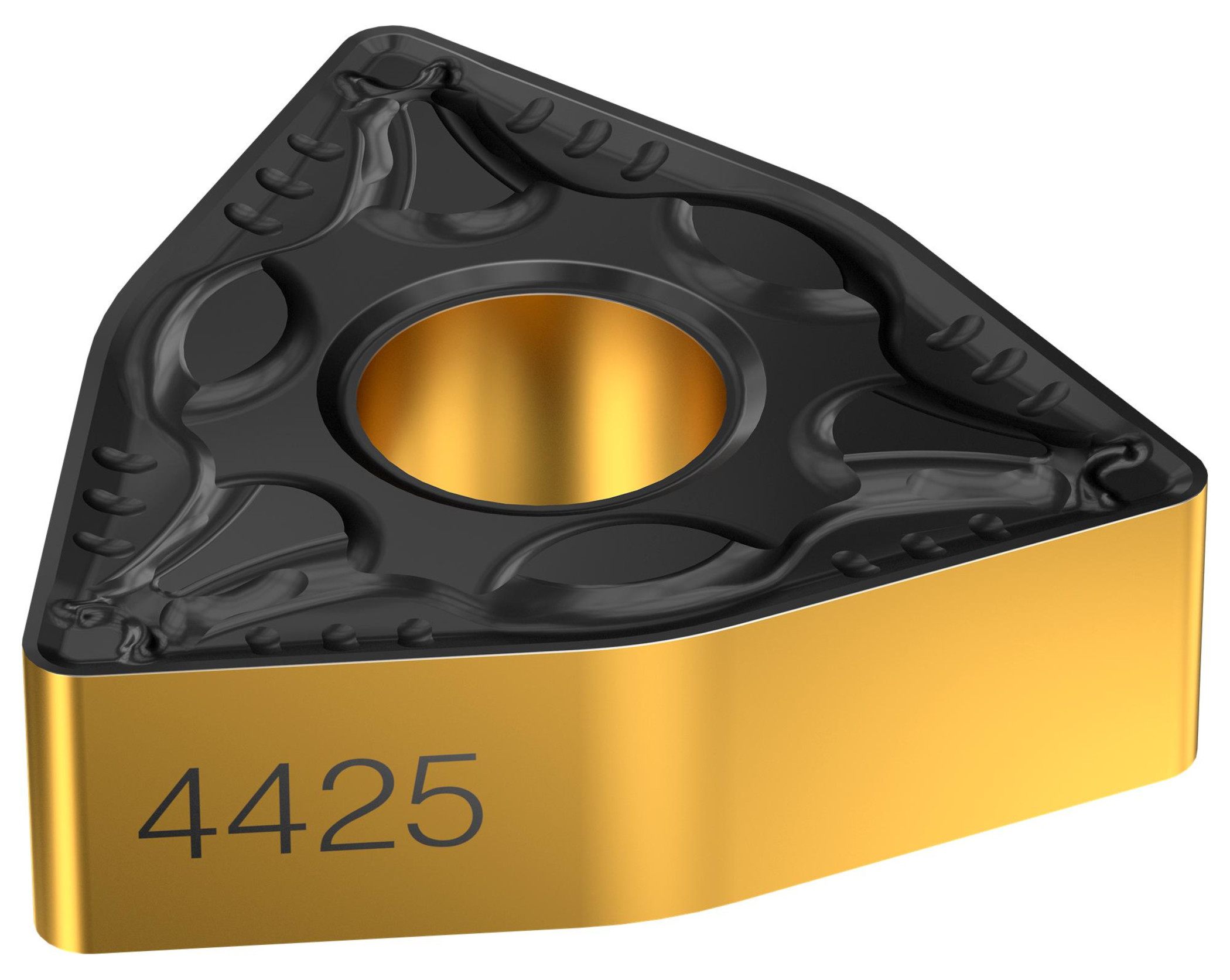 By Staffan Lundström, product manager at Sandvik Coromant
By Staffan Lundström, product manager at Sandvik Coromant
No matter the industry, machine shops are seeing the need for lighter components, greater sustainability and improved fuel efficiency. These needs are driving the use of higher strength and heat resistance materials, as found in cleaner steels and heat resistant super alloys (HRSAs).
This presents a real challenge for manufacturers in terms of tool life and productivity, but also chip control. Each of these factors can be improved by the use of precision coolant. These challenges aren’t only experienced by manufacturers, but also toolmakers like Sandvik Coromant. There is an onus on specialists to acknowledge these advances in materials with inserts that can support customers’ needs. Turning inserts should be able to withstand high temperatures while cutting.
This is why Sandvik Coromant recommends the use of precision coolant.
In the zone
But, what exactly does the use of precision coolant involve? Because steel turning in a machine creates a high-pressure environment, a modern turning tool that features nozzles can produce a high velocity coolant jet.
 By using tool holders with precision nozzles, coolant jets can be directed precisely towards the cutting zone on the rake side of the insert. This will act like a hydraulic wedge to lift the chip, which has two effects: it shortens the contact length between the insert and the material and helps to reduce cutting forces. The end result is a lower temperature with improved chip control.
By using tool holders with precision nozzles, coolant jets can be directed precisely towards the cutting zone on the rake side of the insert. This will act like a hydraulic wedge to lift the chip, which has two effects: it shortens the contact length between the insert and the material and helps to reduce cutting forces. The end result is a lower temperature with improved chip control.
Pre-directed precision over coolant can improve chip formation and increase the process window where no operator is needed. As the use of fully-autonomous digital factories is expected to double over the next five years, according to the Digital Factories 2020: Shaping the future of manufacturing report by Pricewaterhouse Coopers (PwC), such advantages in could be crucial.
Nevertheless, these benefits can only be achieved with tools developed for precision coolant applications — for example, drills with through coolant and turning tools with targeted jets. This is because the required coolant pressure to break the chip for turning tools depends on the nozzle delivery design, material being machined and the depth of cut and feed. The coolant flow required depends on the pressure and the total coolant delivery area.
Choose modular
This why Sandvik Coromant has upgraded its Coromant Capto tool holders for the T Max P carbide turning inserts. The Coromant Capto is a quick-change tool holder that’s designed to reduce set-up and tool change times. It can also support the holy grail objective for manufacturers: increased machine utilization.
The Coromant Capto is a modular system for machining centers, which means it offers a large variety of extension and reduction adaptors to support the assembling of tools with different lengths and design characteristics, regardless of the machine interface. For the end user, the modularity function means less need for expensive specialist tools with long delivery times. The same tools can thus be used in the entire workshop for unique flexibility, optimal rigidity and a minimized tool inventory.
The Coromant Capto has been upgraded to support the T-Max P, which Sandvik Coromant recommends as a first choice for general turning, ranging from medium to large components. T-Max P designed inserts use a number of Sandvik Coromant steel turning grades, including GC4425 and GC4415 deliver improved wear resistance, heat resistance and toughness.
Both materials contain second-generation Inveio coating technology that provides improved crystal orientation for increased wear resistance and an even more consistent performance.
In particular, the T-Max P is designed for through-tool delivery of precision over and under coolant. The holders increase tool life and productivity for ISO S, M and P workpiece materials, which are among the most common and complex. Precision coolant is especially efficient for these difficult-to-machine materials.
Increased tool life
Longer tool lifecycles and improved chip control are essential to cost-effective machining. Both can be aided by reducing heat build-up in the tool by applying coolant. One Sandvik Coromant customer experienced this while machining hub components made from an unalloyed steel, P1.2.Z.AN (CMC 01.2), using flood coolant. The existing process subjected the workpiece to rough turning in an Okuma horizontal lathe, and produced up to 30 pieces before signs of wear were noticed on the tool.
The machine shop wanted to improve the chip control and tool life, with improved process security and cycle times. To achieve this, the customer swapped its existing insert with a CoroTurn 300 QS shank tool for turning using precision coolant instead of flood coolant. The end result was that the customer was able to machine up to 79 components before the tool showed signs of wear — an increase in tool life of more than 263%.
Overall, using the CoroTurn 300 QS with precision coolant increased the machine shop’s productivity by 180%.
Of course, these advantages also benefit the bottom line. In another instance, a Sandvik Coromant customer in aerospace was able to machine two sets of main landing gear for an aircraft with a single tool, the GC4425 in combination over and under coolant. The previous solution, using a competitor’s tool with flood coolant, only machined 0.8 components before signs of wear were noticed. Again, this led to much increased tool life — by 250%.
The customer could now run two full components before any risk of insert failure, gaining productivity and cycle time by removing the stop for insert change. This equated to a 29% cost reduction.
New ideas for machining
These cases show that precision over and under coolant can significantly improve tool life performance and component quality. Moreover, precision coolant from above can be vital to controlling chip breaking for secure machining, while under coolant controls the temperature for a long and predictable tool life.
The coolant technology also has positive effects on surface quality — making it integral to any manufacturer’s approach to quality production. In support of this, Sandvik Coromant’s specialists can offer coolant usage and pressure recommendations for steel turning.
And, there is Sandvik Coromant’s PrimeTurning, an ethos that allows all-directional turning for maximized productivity. The methodology is based on the tool entering the component at the chuck, and removing material as it travels towards the end of the component. This prioritises all-important metal removal rates, and also means faster, quality production and changeovers.
By applying better tools with the right ethos — and, of course, with precision coolant with the T-Max P — rigor and precision can be central to any manufacturing company’s steel turning setup. Machine shops can ensure customers receive workpieces on time and at optimal cost with quality, talent and elegance.
Contact Details
Related Glossary Terms
- alloys
alloys
Substances having metallic properties and being composed of two or more chemical elements of which at least one is a metal.
- centers
centers
Cone-shaped pins that support a workpiece by one or two ends during machining. The centers fit into holes drilled in the workpiece ends. Centers that turn with the workpiece are called “live” centers; those that do not are called “dead” centers.
- chuck
chuck
Workholding device that affixes to a mill, lathe or drill-press spindle. It holds a tool or workpiece by one end, allowing it to be rotated. May also be fitted to the machine table to hold a workpiece. Two or more adjustable jaws actually hold the tool or part. May be actuated manually, pneumatically, hydraulically or electrically. See collet.
- coolant
coolant
Fluid that reduces temperature buildup at the tool/workpiece interface during machining. Normally takes the form of a liquid such as soluble or chemical mixtures (semisynthetic, synthetic) but can be pressurized air or other gas. Because of water’s ability to absorb great quantities of heat, it is widely used as a coolant and vehicle for various cutting compounds, with the water-to-compound ratio varying with the machining task. See cutting fluid; semisynthetic cutting fluid; soluble-oil cutting fluid; synthetic cutting fluid.
- depth of cut
depth of cut
Distance between the bottom of the cut and the uncut surface of the workpiece, measured in a direction at right angles to the machined surface of the workpiece.
- feed
feed
Rate of change of position of the tool as a whole, relative to the workpiece while cutting.
- lathe
lathe
Turning machine capable of sawing, milling, grinding, gear-cutting, drilling, reaming, boring, threading, facing, chamfering, grooving, knurling, spinning, parting, necking, taper-cutting, and cam- and eccentric-cutting, as well as step- and straight-turning. Comes in a variety of forms, ranging from manual to semiautomatic to fully automatic, with major types being engine lathes, turning and contouring lathes, turret lathes and numerical-control lathes. The engine lathe consists of a headstock and spindle, tailstock, bed, carriage (complete with apron) and cross slides. Features include gear- (speed) and feed-selector levers, toolpost, compound rest, lead screw and reversing lead screw, threading dial and rapid-traverse lever. Special lathe types include through-the-spindle, camshaft and crankshaft, brake drum and rotor, spinning and gun-barrel machines. Toolroom and bench lathes are used for precision work; the former for tool-and-die work and similar tasks, the latter for small workpieces (instruments, watches), normally without a power feed. Models are typically designated according to their “swing,” or the largest-diameter workpiece that can be rotated; bed length, or the distance between centers; and horsepower generated. See turning machine.
- rake
rake
Angle of inclination between the face of the cutting tool and the workpiece. If the face of the tool lies in a plane through the axis of the workpiece, the tool is said to have a neutral, or zero, rake. If the inclination of the tool face makes the cutting edge more acute than when the rake angle is zero, the rake is positive. If the inclination of the tool face makes the cutting edge less acute or more blunt than when the rake angle is zero, the rake is negative.
- shank
shank
Main body of a tool; the portion of a drill or similar end-held tool that fits into a collet, chuck or similar mounting device.
- shaping
shaping
Using a shaper primarily to produce flat surfaces in horizontal, vertical or angular planes. It can also include the machining of curved surfaces, helixes, serrations and special work involving odd and irregular shapes. Often used for prototype or short-run manufacturing to eliminate the need for expensive special tooling or processes.
- turning
turning
Workpiece is held in a chuck, mounted on a face plate or secured between centers and rotated while a cutting tool, normally a single-point tool, is fed into it along its periphery or across its end or face. Takes the form of straight turning (cutting along the periphery of the workpiece); taper turning (creating a taper); step turning (turning different-size diameters on the same work); chamfering (beveling an edge or shoulder); facing (cutting on an end); turning threads (usually external but can be internal); roughing (high-volume metal removal); and finishing (final light cuts). Performed on lathes, turning centers, chucking machines, automatic screw machines and similar machines.
- wear resistance
wear resistance
Ability of the tool to withstand stresses that cause it to wear during cutting; an attribute linked to alloy composition, base material, thermal conditions, type of tooling and operation and other variables.

